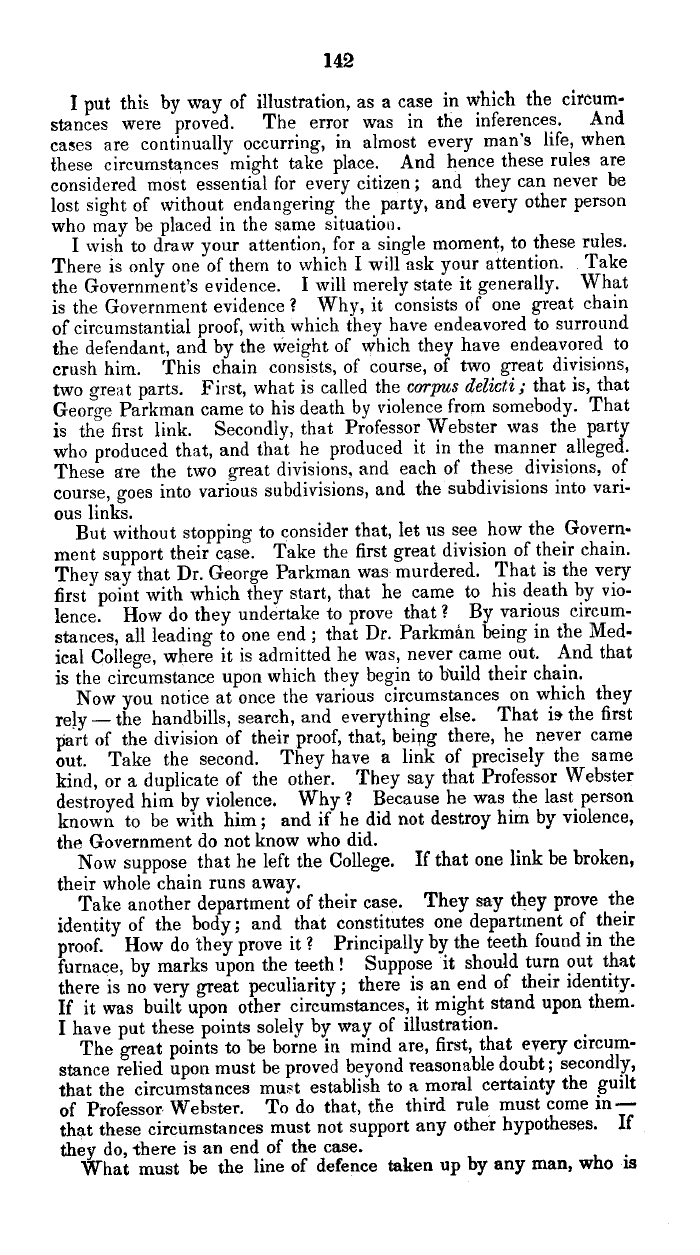|
142
1 put thi: by way of illustration, as a case in which the circum-
stances were proved. The error was in the inferences. And
cases are continually occurring, in almost every man's life, when
these circumstances might take place. And hence these rules are
considered most essential for every citizen; and they can never be
lost sight of without endangering the party, and every other person
who may be placed in the same situation.
I wish to draw your attention, for a single moment, to these rules.
There is only one of them to which I will ask your attention. . Take
the Government's evidence. I will merely state it generally. What
is the Government evidence ? Why, it consists of one great chain
of circumstantial proof, with which they have endeavored to surround
the defendant, and by the weight of which they have endeavored to
crush him. This chain consists, of course, of two great divisions,
two great parts. First, what is called the corpus delicti; that is, that
George Parkman came to his death by violence from somebody. That
is the first link. Secondly, that Professor Webster was the party
who produced that, and that he produced it in the manner alleged.
These are the two great divisions, and each of these divisions, of
course, goes into various subdivisions, and the subdivisions into vari-
ous links.
But without stopping to consider that, let us see how the Govern-
ment support their case. Take the first great division of their chain.
They say that Dr. George Parkman was murdered. That is the very
first point with which they start, that he came to his death by vio-
lence. How do they undertake to prove that? By various circum-
stances, all leading to one end ; that Dr. Parkman being in the Med-
ical College, where it is admitted he was, never came out. And that
is the circumstance upon which they begin to build their chain.
Now you notice at once the various circumstances on which they
rely - the handbills, search, and everything else. That i9 the first
part of the division of their proof, that, being there, he never came
out. Take the second. They have a link of precisely the same
kind, or a duplicate of the other. They say that Professor Webster
destroyed him by violence. Why? Because he was the last person
known to be with him; and if he did not destroy him by violence,
the Government do not know who did.
Now suppose that he left the College. If that one link be broken,
their whole chain runs away.
Take another department of their case. They say they prove the
identity of the body; and that constitutes one department of their
proof. How do they prove it ? Principally by the teeth found in the
furnace, by marks upon the teeth! Suppose it should turn out that
there is no very great peculiarity; there is an end of their identity.
If it was built upon other circumstances, it might stand upon them.
I have put these points solely by way of illustration.
The great points to be borne in mind are, first, that every circum-
stance relied upon must be proved beyond reasonable doubt; secondly,
that the circumstances must establish to a moral certainty the guilt
of Professor Webster. To do that, the third rule must come in-
that these circumstances must not support any other hypotheses. If
they do, there is an end of the case.
What must be the line of defence taken up by any man, who is
|

